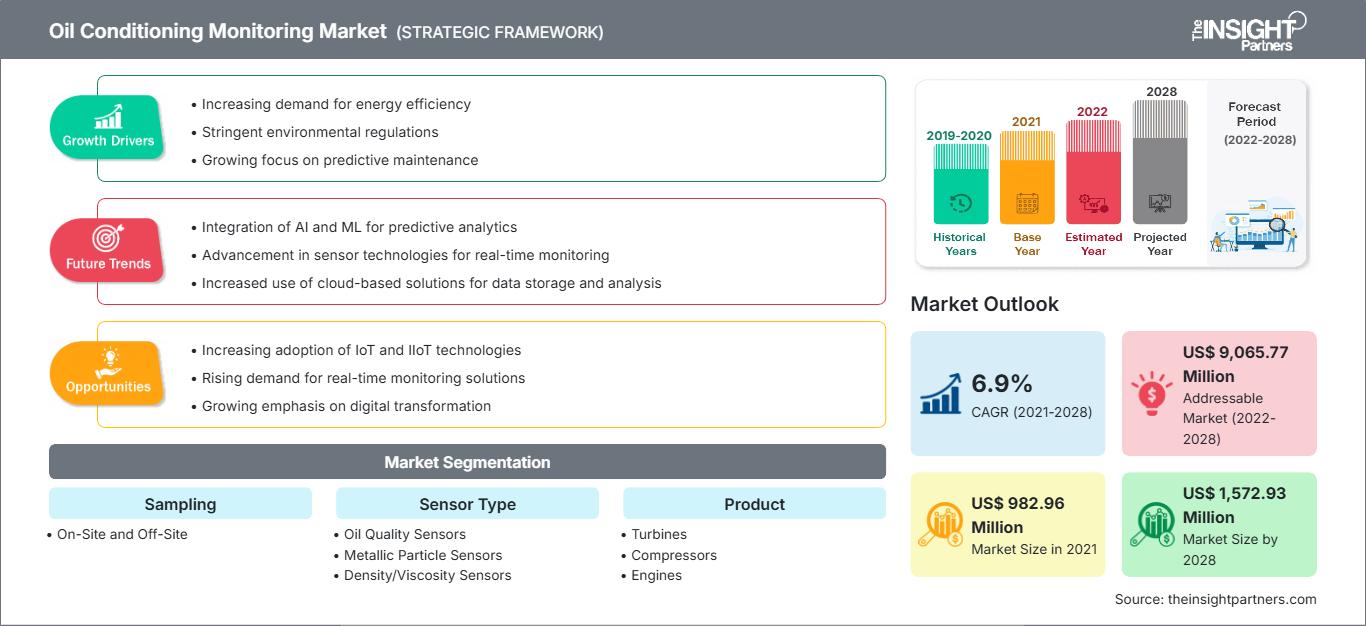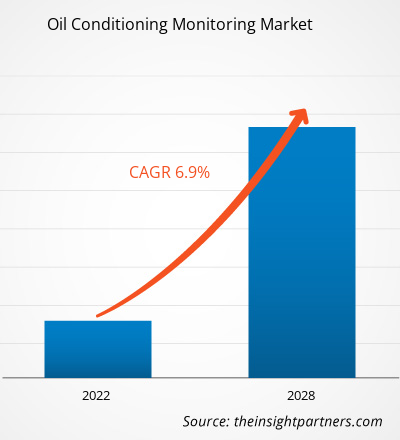석유 컨디션 모니터링 시장은 2021년 9억 8,296만 달러에서 2028년 15억 7,293만 달러로 성장할 것으로 예상되며, 2021년부터 2028년까지 연평균 성장률 6.9%로 성장할 것으로 예상됩니다.
산업용 사물 인터넷(IIoT)의 활용은 효율성 향상, 안전 위험 감소, 이동 감소 등 석유 및 가스 산업의 환경적 영향을 크게 줄이고 있습니다. 석유 및 가스 기업들은 IIoT에 주목하고 있는데, 이는 에너지 절약, 석유 유출 및 기타 재난 방지, 탄소 배출량 감소에 도움이 될 수 있기 때문입니다. IIoT는 에너지 및 자원 소비를 모니터링할 수도 있습니다. 지능형 기술은 운영부터 소비자 상호작용에 이르기까지 석유 및 가스 공급망의 거의 모든 영역에 영향을 미치고 있습니다. 공급망의 스마트 기기는 석유 및 가스 산업이 상품화된 세상에서 경쟁할 수 있는 기회를 제공하는 동시에 기존 산업을 빠르게 현대화할 수 있는 기회를 제공합니다. 또한, 사물 인터넷(IoT)은 데이터 수집 방식을 크게 개선할 수 있는 잠재력을 가지고 있습니다. 석유 및 가스 부문은 다른 어떤 산업보다 효율성과 정밀성을 더욱 중요하게 생각합니다.
이 보고서의 일부, 국가 수준 분석, Excel 데이터 팩을 포함하여 모든 보고서에 대한 사용자 정의를 무료로 받을 수 있을 뿐만 아니라 스타트업 및 대학을 위한 훌륭한 제안 및 할인을 이용할 수 있습니다
오일 컨디셔닝 모니터링 시장: 전략적 통찰력

- 이 보고서의 주요 주요 시장 동향을 확인하세요.이 무료 샘플에는 시장 동향부터 추정 및 예측에 이르기까지 데이터 분석이 포함됩니다.
COVID-19 팬데믹은 전 세계 여러 산업을 뒤흔들었습니다. 봉쇄 조치는 제조업과 IT를 포함한 다양한 산업의 운영에 차질을 빚었습니다. 그러나 FMCG(일용소비재) 및 제약과 같은 필수 산업은 운영을 지속해야 했습니다. 석유 부문은 지난 12개월 동안 세 번째 가격 폭락을 겪고 있습니다. 석유 산업은 처음 두 차례의 충격 이후 회복세를 보이며 정상적인 사업 운영을 재개했습니다. 그러나 이번에는 상황이 다릅니다. 현재 상황은 공급 충격, 역사적으로 낮은 수요, 그리고 전 세계적인 인도주의적 재난을 포함하고 있습니다. 더욱이 이 부문의 재정 및 구조적 건전성은 과거 위기 때보다 악화되었습니다. 셰일 가스 도입, 과잉 생산, 그리고 자본 규율의 부재를 무시한 자유로운 금융 시장이 저조한 수익률의 원인으로 지목되고 있습니다. 유가가 30년 만에 최저치에 근접하고 여론의 압력이 커지면서, 지도자들은 변화가 불가피하다는 것을 인식했습니다. COVID-19 문제는 더욱 심화되고 있습니다. 따라서 COVID-19 팬데믹과 그 여파는 오일 컨디셔닝 모니터링 시장에 큰 타격을 주고 있습니다.
오일 컨디셔닝 모니터링 시장 분석: 전 세계 발전 수요 증가가 오일 컨디셔닝 모니터링 시장 성장 촉진
전 세계 인구 증가와 중국, 인도 등 개발도상국의 경제 및 산업 성장으로 인해 향후 몇 년 동안 전 세계 에너지 소비량이 증가할 것으로 예상되며, 2035년까지 연간 에너지 사용량은 약 778에타줄에 달할 것으로 예상됩니다. 산업 기계 및 기타 장비 설계자와 제조업체는 난방 및 냉방 손실 감소, 열 전달 개선, 전기 모터 개선을 통해 제품의 에너지 효율을 향상시킬 방법을 끊임없이 모색하고 있습니다. 안정적인 기저부하 전력의 필요성, 지구 기후 변화 위협 등의 요인으로 인해 원자력 발전은 여전히 필수적입니다. 또한, 원자력은 거의 탄소 배출이 없는 유일한 대규모 전력 공급원이기 때문에 에너지 전략의 핵심 요소입니다. 원자력 발전은 전 세계 전력의 약 20%, 저탄소 에너지의 60% 이상을 생산합니다. 원자력 발전소는 증가하는 전력 수요를 충족하는 에너지원으로 부상했습니다. 원자력 발전소는 핵연료 주기 문제와 더불어 수명 주기의 일부 또는 자연재해 또는 인재 발생 시 원자력 발전소의 해체라는 문제에 직면해 있으며, 이로 인해 발전소 내 오일 컨디셔닝 모니터링 수요가 증가하고 있습니다.
샘플링 기반 시장 분석
샘플링을 기준으로 전 세계 오일 컨디셔닝 모니터링 시장은 현장(on-site)과 현장 외(off-site)로 구분됩니다. 2020년에는 현장 외 부문이 시장 점유율을 크게 확대하며 시장을 주도했습니다.센서 유형 기반 시장 분석
센서 유형을 기준으로 오일 컨디셔닝 모니터링 시장은 오일 품질 센서, 금속 입자 센서, 밀도/점도 센서로 구분됩니다. 2020년에는 오일 품질 센서 부문이 오일 컨디셔닝 모니터링 부문을 이끌며 시장 점유율 1위를 차지했습니다.제품 기반 시장 분석
오일 컨디셔닝 모니터링 시장은 제품별로 터빈, 압축기, 엔진, 기어 시스템, 유압 시스템으로 구분됩니다. 2020년에는 터빈 부문이 오일 컨디셔닝 모니터링 부문을 이끌며 시장 점유율 1위를 차지했습니다.측정 기반 시장 분석
오일 컨디셔닝 모니터링 시장은 측정 기준으로 온도, 압력, 밀도, 점도, 유전율, 총산가(TAN)/총탄가(TBN), 수분 희석, 연료 희석, 그을음, 마모 입자로 구분됩니다. 2020년에는 점도 부문이 오일 컨디셔닝 모니터링 부문을 이끌며 시장 점유율 1위를 차지했습니다.산업 기반 시장 분석
산업별로 오일 컨디셔닝 모니터링 시장은 운송, 산업, 석유 및 가스, 에너지 및 전력, 광업으로 구분됩니다. 2020년에는 운송 부문이 시장 점유율 1위를 차지했으며, 오일 컨디셔닝 모니터링 부문도 시장 점유율 1위를 차지했습니다.
오일 컨디셔닝 모니터링 시장에서 활동하는 기업들은 인수합병, 시장 주도권 확보 등의 전략을 통해 시장 지위를 유지하고 있습니다. 주요 기업들의 몇 가지 발전 사례는 다음과 같습니다.
- 2020년 8월, ALS는 로체스터에 본사를 둔 고급 온라인 오일 컨디셔닝(OCM) 솔루션 개발업체인 포세이돈 시스템즈와 전략적 협력을 시작했습니다. 두 회사는 Poseidon Systems의 수상 경력에 빛나는 온라인 OCM 기술과 ALS의 오일 분석 및 테스트 경험을 결합하여 OCM을 혁신한다는 공통 목표를 가지고 있습니다.
- 2020년 8월, 공정 장비의 신뢰성을 개선하고 윤활유 수명을 연장하는 특수 여과 제품의 글로벌 제조업체인 Des-Case Corporation은 산업용 윤활 자산을 위한 새로운 원격 진단 모니터링 구독 플랜 출시를 발표했습니다. 이를 통해 고객은 중요 자산 내부의 윤활유 상태, 청결도 및 습도를 실시간으로 모니터링할 수 있다는 안도감을 얻을 수 있습니다.
오일 컨디셔닝 모니터링 시장
The Insight Partners의 분석가들은 예측 기간 동안 오일 컨디셔닝 모니터링 시장에 영향을 미치는 지역별 동향과 요인을 면밀히 분석했습니다. 이 섹션에서는 북미, 유럽, 아시아 태평양, 중동 및 아프리카, 그리고 중남미 지역의 오일 컨디셔닝 모니터링 시장 부문 및 지역별 현황도 살펴봅니다.
오일 컨디셔닝 모니터링 시장 보고서 범위
| 보고서 속성 | 세부 |
|---|---|
| 시장 규모 2021 | US$ 982.96 Million |
| 시장규모별 2028 | US$ 1,572.93 Million |
| 글로벌 CAGR (2021 - 2028) | 6.9% |
| 이전 데이터 | 2019-2020 |
| 예측 기간 | 2022-2028 |
| 다루는 세그먼트 |
By 샘플링
|
| 포함된 지역 및 국가 | 북미
|
| 시장 선도 기업 및 주요 회사 프로필 |
|
오일 컨디셔닝 모니터링 시장 참여자 밀도: 비즈니스 역학에 미치는 영향 이해
오일 컨디셔닝 모니터링 시장은 소비자 선호도 변화, 기술 발전, 그리고 제품 효능에 대한 인식 제고 등의 요인으로 인한 최종 사용자 수요 증가에 힘입어 빠르게 성장하고 있습니다. 수요가 증가함에 따라 기업들은 제품 라인업을 확장하고, 소비자 니즈를 충족하기 위한 혁신을 추진하며, 새로운 트렌드를 적극 활용하고 있으며, 이는 시장 성장을 더욱 가속화하고 있습니다.

- 을 얻으세요 오일 컨디셔닝 모니터링 시장 주요 주요 플레이어 개요
글로벌 오일 컨디셔닝 모니터링 시장은 아래와 같이 세분화되었습니다.
샘플링 기준
- 현장
- 현장 밖
센서 유형 기준
- 오일 품질 센서
- 금속 입자 센서
- 밀도/점도 센서
제품 기준
- 터빈
- 압축기
- 엔진
- 기어 시스템
- 유압 시스템
측정 기준
- 온도
- 압력
- 밀도
- 점도
- 유전체
- TAN/TBN
- 물 희석
- 연료 희석
- 그을음
- 마모 입자
산업별
- 운송
- 산업
- 석유 및 가스
- 에너지 및 전력
- 광산
지리별
- 북미
- 미국
- 캐나다
- 멕시코
- 유럽
- 프랑스
- 독일
- 이탈리아
- 영국
- 러시아
- 유럽의 나머지 지역
- 아시아 태평양(APAC)
- 중국
- 인도
- 한국
- 일본
- 호주
- APAC의 나머지 지역
- 중동 및 아프리카(MEA)
- 남아프리카공화국
- 사우디아라비아
- UAE
- MEA 기타 지역
- 남아메리카(SAM)
- 브라질
- 아르헨티나
- SAM 기타 지역
회사 프로필
- CM Technologies GmbH
- Des-Case
- Hydac Technology Limited
- Intertek Group Plc.
- Poseidon Systems
- Rheonics Group
- SGS SA
- Special Oilfield Services Co. LLC
- TAN Delta Systems Limited
- Veritas Petroleum Services
- 과거 분석(2년), 기준 연도, CAGR을 포함한 예측(7년)
- PEST 및 SWOT 분석
- 시장 규모 가치/거래량 - 글로벌, 지역, 국가
- 산업 및 경쟁 환경
- Excel 데이터세트
최근 보고서
관련 보고서
사용 후기
구매 이유
- 정보에 기반한 의사 결정
- 시장 역학 이해
- 경쟁 분석
- 고객 인사이트
- 시장 예측
- 위험 완화
- 전략 기획
- 투자 타당성 분석
- 신흥 시장 파악
- 마케팅 전략 강화
- 운영 효율성 향상
- 규제 동향에 발맞춰 대응




















 무료 샘플 받기 - 오일 컨디셔닝 모니터링 시장
무료 샘플 받기 - 오일 컨디셔닝 모니터링 시장